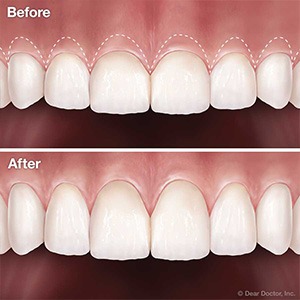
Crown Lengthening Procedure
Is Crown Lengthening Necessary?
Contents
Your smile says a lot about you. It can determine whether you can interact freely with your friends and colleagues. However, some issues can affect how your smile looks, such as having excessive gingival tissue. This is known as a gummy smile, a condition that a dentist can fix.
Not unless you know much about dentistry, there is a chance that you may have never heard of a procedure known as crown lengthening. Before we see why you may need to undergo the crown lengthening process, let’s see what crown lengthening is about.
What is the Dental Crown Lengthening Procedure?
Dental crown lengthening is a surgical procedure that involves removing gum tissue and sometimes bone to expose more of a tooth’s surface. The goal of the procedure is to make more of the tooth visible so that a crown or filling can be placed on it.
The crown refers to the top part of the tooth, the visible part. A crown lengthening procedure does not cause the tooth to become longer. Instead, the gum tissue at the tooth’s base is reshaped or removed to expose more of the natural tooth. This can be done on just one tooth or on an entire line of teeth to produce a natural, broad smile. It can also be performed to even out the gum line.

A crown lengthening procedure may also be needed to prepare a restorative or cosmetic dental procedure. If a tooth is decayed, broken, or requires additional tooth structure to support a dental crown or bridge, your dentist may need to perform a crown lengthening to expose more of the tooth to work with.
The procedure is usually performed by a periodontist, a dentist specializing in treating gum disease and other conditions affecting the gums and supporting structures of the teeth. The procedure is typically done under local anesthesia, which numbs the area being worked on.
During the procedure, the periodontist will make incisions in the gum tissue to expose the tooth’s root and surrounding bone. They may also remove some of the bone tissue to ensure that enough of the tooth is exposed. Once the procedure is complete, the gum tissue is sutured back into place.
After the procedure, the patient will typically experience some swelling and discomfort, which can be managed with pain medication and ice packs.
Tooth Crown Lengthening
The procedure can usually be completed in one visit, but how long it takes will depend on how many teeth are being treated. A local anesthetic will be applied to keep you comfortable; a sedative can also be administered to patients who are feeling anxious.
Your dentist or periodontist will cut into the gums and pull them away from the teeth. Depending on the goal of the surgery, either gum and bone tissue will be removed or just gum tissue. The area will be cleaned before sutures are placed to seal it.
You may receive painkillers to help with discomfort following the procedure and a specialized mouth rinse to help the area heal properly.
Alternatives to Crown Lengthening
There are some alternatives to crown lengthening, including:
- Orthodontic treatment: If you have a gummy smile or your teeth appear too short, orthodontic treatment may be an alternative to crown lengthening. Braces or aligners can reposition the teeth and make them appear longer.
- Gum contouring: This procedure removes excess gum tissue to make the teeth appear longer. This is a less invasive alternative to crown lengthening and is typically used for mild cases of a gummy smile.
- Bonding or veneers: Bonding or veneers can make the teeth appear longer by adding a layer of composite or porcelain.
- Surgical lip repositioning: This procedure is used to lower the position of the upper lip to make the teeth appear longer. This procedure is typically used for patients with a gummy smile.
- Botox injections: Botulinum toxin injections can reduce the activity of the muscles that control the upper lip, resulting in a less gummy smile. This is a temporary solution and typically lasts around 3-4 months.
It’s important to discuss these options with your dentist to determine which one is best suited for your specific situation.
Crown Lengthening vs. Gingivectomy
Crown lengthening and gingivectomy are two procedures used to reshape gum tissue. While they can be used interchangeably in some cases, they are different procedures with different indications and goals.
Crown lengthening is a surgical procedure that involves removing gum tissue and bone to expose more of the tooth’s structure. The goal is to increase the length of the tooth’s clinical crown, which is the portion of the tooth that is visible above the gum line. Crown lengthening is typically done for cosmetic reasons, such as to improve the appearance of a “gummy” smile, or for restorative reasons, such as to prepare a tooth for a dental crown or bridge.
On the other hand, gingivectomy is a surgical procedure involving removing gum tissue to treat periodontal disease. A gingivectomy aims to reduce the size of the periodontal pockets around the teeth, making it easier to clean the teeth and prevent further damage to the gum tissue and bone. Gingivectomy can also be used to remove excess gum tissue in cases of gum overgrowth or hyperplasia.
Crown lengthening is a dental procedure to expose or reveal more of your tooth crown. The crown is the visible part of your tooth that sits above the gum line.
The crown lengthening process is painless and straightforward, and it involves removing some of your gum tissue, thus moving your gums closer to the tooth root. The procedure is performed for functional and aesthetic purposes.
You can use different crown lengthening techniques depending on the cause of the excess gingival tissue and the condition of your mouth. The techniques include gingivectomy, surgical extrusion, and apically repositioned flap surgery.
Your dentist will choose the appropriate technique after considering the following:
- The proximity of the root
- Aesthetic considerations
- The appearance of the root
- The length of the crown as compared to the root (crown to root ratio)
- The position of the affected teeth
- The need for a tooth cap or filling
- The presence of bone loss
Why Would You Need Crown Lengthening?
Crown lengthening is a dental procedure involving removing gum tissue, bone, or both to expose more of a tooth’s surface. This procedure is usually done to improve the health of gums, teeth, or both. There are several reasons why someone might need crown lengthening:
Gummy Smile
Crown lengthening can remove excess gum tissue to reveal more of the tooth, making the teeth appear longer and improving the smile’s overall appearance.
A gummy smile is a scenario where a lot of gum tissue covers a more significant portion of the tooth. In turn, this makes your teeth seem small. A gummy smile can be caused by a condition known as passive eruption, where much of your tooth is covered by your gums when they come in. Also, your front teeth may over-erupt, causing your gums to grow too far.
Therefore, the dentist will use a laser or scalpel to remove the excess gum tissue when you undergo the crown lengthening procedure. You will not be in pain since local anesthesia will be used.
Once complete, your teeth will look more extended and more aesthetically pleasing.
Damaged Teeth
If there’s an accident or you have tooth decay, and your teeth have been damaged below the gum line, it might be difficult for our dentist to work on the area that has been damaged. Therefore, crown lengthening becomes the best possible solution. Once your dentist has exposed the part of the tooth covered by your gums, they can repair it.
No Room for Dental Crowns
Crown lengthening may be necessary if a tooth is too short or lacks enough tooth structure to support a dental restoration, such as a crown or bridge.
There are instances when you might not have enough natural teeth above the gum line to accommodate an artificial dental crown. If a dental crown is fixed when you don’t have enough room to accommodate it, you can experience discomfort and chronic inflammation.
Even though there are other options, crown lengthening can be performed to expose more of the tooth structure. When this is done, a crown can be fixed and fit completely and comfortably.
To Improve Your Dental Aesthetics
Crown lengthening can even out an uneven gum line and create a more aesthetically pleasing smile.
In most cases, if you have teeth that are mostly covered with gums is not aesthetically pleasing. So, to get a more proportionate smile, you will need crown lengthening. Exposed gums should not be more than 3 millimeters. If more than that is visible, the aesthetics will be affected.
Therefore, crown lengthening will be performed if you use porcelain veneers to improve your smile’s aesthetics. There isn’t enough room to accommodate them due to excess gingival tissue. It will create room for the veneers so that they can fit perfectly.
To Prevent Oral Health Issues
Crown lengthening can remove infected gum tissue and allow the dentist to clean and disinfect the area more effectively.
Excessive gum tissue can pose a threat to your oral health. When you have a gumline, you may have difficulty cleaning your teeth, and bacteria can accumulate, leading to periodontitis and tooth decay. Crown lengthening can ensure that the extra tissue is removed, making cleaning your teeth easier.
Conclusion
Crown lengthening is a standard procedure used to treat various dental conditions, including fractured teeth, teeth with decay below the gum line, and teeth with the insufficient structure for restoration. It is also used to improve the appearance of a “gummy” smile, where too much gum tissue is visible when a person smiles.

